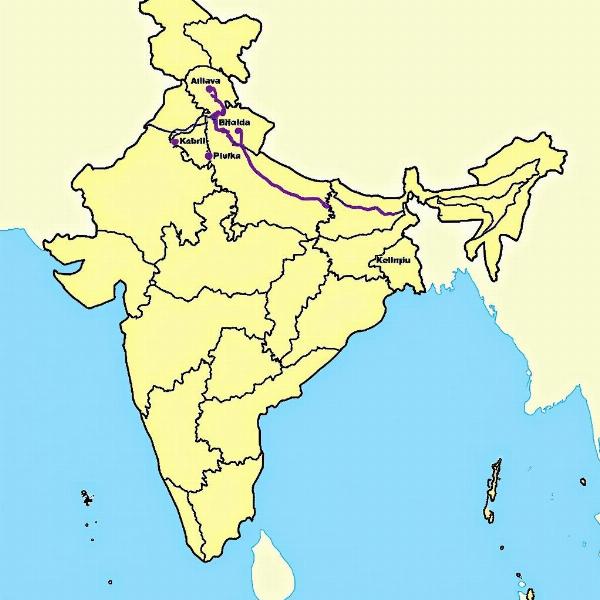Understanding the concept of a river basin is crucial for grasping the complexities of water management, geography, and environmental studies. This article explores the “river basin meaning in Hindi,” delving into its significance, components, and related terminology. We’ll also examine the cultural and economic importance of river basins in India, a nation where rivers hold immense spiritual and practical value.
What Does River Basin Mean in Hindi?
The Hindi term for river basin is “नदी द्रोणी” (nadi droni). “Nadi” means river, and “droni” translates to basin or trough. So, “nadi droni” literally refers to the area drained by a river and its tributaries. It encompasses the entire land surface from which water flows into a particular river system. This includes the main river, its tributaries, and the surrounding land that contributes to the water flow. Think of it as a giant funnel, collecting rainwater and directing it towards a single outlet—the river mouth.
Components of a River Basin
A river basin is more than just the river itself. It comprises several interconnected elements:
- Main River: The primary river channel that drains the basin.
- Tributaries: Smaller rivers and streams that flow into the main river. These contribute significantly to the overall water volume.
- Watershed: The boundary separating one river basin from another. It’s often a ridge or high ground.
- Groundwater: Water stored beneath the surface, which also contributes to the river’s flow.
- Riparian Zone: The area alongside the riverbanks, characterized by unique vegetation and ecosystems.
The Importance of River Basins in India
In India, river basins are fundamental to life, playing a crucial role in agriculture, industry, and even spiritual practices. The Ganges, Brahmaputra, and Indus are just a few examples of rivers that have shaped Indian civilization. tributes meaning in hindi
 Map of Indian River Basins
Map of Indian River Basins
“River basins are the lifeblood of India,” says Dr. Anika Sharma, a renowned hydrologist. “They provide water for irrigation, drinking, and industrial use, supporting millions of livelihoods.”
Understanding River Basin Management
Effective river basin management is crucial for ensuring sustainable water use and protecting the environment. This involves coordinating activities across the entire basin, considering the needs of all stakeholders.
Why is River Basin Management Important?
- Water Scarcity: Proper management helps ensure equitable distribution of water resources.
- Pollution Control: It helps mitigate pollution from various sources.
- Flood Control: Managing water flow can help prevent devastating floods.
- Ecosystem Protection: Maintaining the health of the river and its surrounding environment.
River Basin vs. Watershed: What’s the Difference?
While often used interchangeably, “river basin” and “watershed” are distinct terms. A watershed is the dividing line between two basins, while the river basin is the entire area drained by a river system. epeirogenic meaning in hindi
“Understanding the difference between a watershed and a river basin is crucial for effective water management,” explains Dr. Rohan Verma, an environmental scientist. “Focusing on the watershed allows us to target interventions that prevent inter-basin conflicts and promote sustainable resource utilization.”
Conclusion
The concept of a “river basin,” or “nadi droni” in Hindi, is integral to understanding water resources and their management. From providing water for agriculture and industry to supporting diverse ecosystems, river basins are vital for life in India. Understanding their components and the principles of effective management is crucial for ensuring the sustainable use of these invaluable resources.
FAQ
- What is the largest river basin in India? The Ganges-Brahmaputra-Meghna basin is the largest in India.
- Why are river basins important for agriculture? River basins provide the water necessary for irrigation, crucial for agricultural production.
- How does pollution affect river basins? Pollution contaminates the water, harming aquatic life and making it unsafe for human use.
- What is integrated river basin management? It’s a holistic approach to managing water resources, considering all aspects of the basin.
- How can I contribute to river basin protection? Simple actions like reducing water consumption and proper waste disposal can make a difference.
- What is the difference between a river basin and a catchment area? A catchment area and a river basin are essentially the same, referring to the area from which a river gathers its water.
- What are the challenges in river basin management in India? Challenges include increasing water demand, pollution, and climate change.
Meaning-Hindi.in is your trusted partner for professional translation services between Hindi and various other languages. We offer specialized expertise in business, legal, technical, website localization, educational, and urgent translations. Our team of expert linguists ensures accurate, culturally sensitive, and high-quality translations tailored to your specific needs. Contact us today for all your translation requirements at [email protected] or call us at +91 11-4502-7584. Meaning-Hindi.in is dedicated to bridging language barriers and facilitating effective communication across cultures.